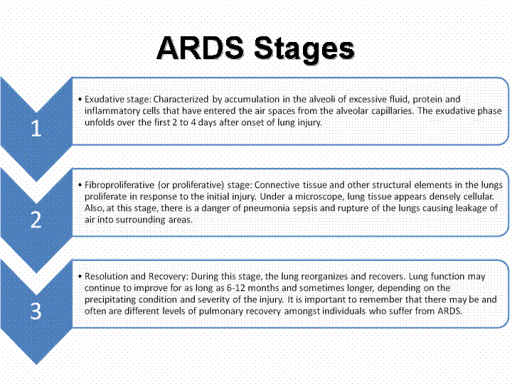| front |1 |2 |3 |4 |5 |6 |7 |8 |9 |10 |11 |12 |13 |14 |15 |16 |17 |18 |19 |review |
 |
THE STAGES OF ARDS
ARDS has generally been
characterized into three stages. In full-blown cases, these three
stages unfold
sequentially over a period of several weeks to several
months.
1 Exudative stage: Characterized
by accumulation in the alveoli of excessive fluid, protein and
inflammatory cells that have entered the air spaces from
the alveolar capillaries. The exudative phase unfolds over the first
2 to 4 days after onset of lung injury.
2 Fibroproliferative (or
proliferative) stage: Connective tissue and other structural
elements in the lungs
proliferate in response to the initial injury. Under a
microscope, lung tissue appears densely cellular. Also, at this
stage, there is a danger of pneumonia sepsis and rupture of the
lungs causing leakage of air into surrounding areas.
3 Resolution and Recovery: During
this stage, the lung reorganizes and recovers. Lung function may
continue to improve for as long as 6-12 months and
sometimes longer, depending on the precipitating condition and
severity of the injury. It is important to remember that there may
be and often are different levels of pulmonary recovery amongst
individuals who suffer from ARDS.
Some experts recognize a fourth
phase of ARDS. This is the period longer than six to twelve months
after onset, when some patients experience continued
health problems caused by the acute illness. These problems may
include cough, limited exercise tolerance and fatigue. Others
experience anxiety, depression and flashback memories of their
critical illness, which are very similar to post-traumatic stress
disorder. This fourth phase is incompletely characterized, and is
very much in need of research.
|